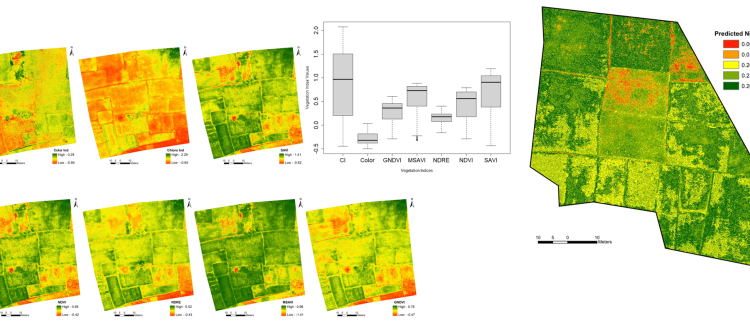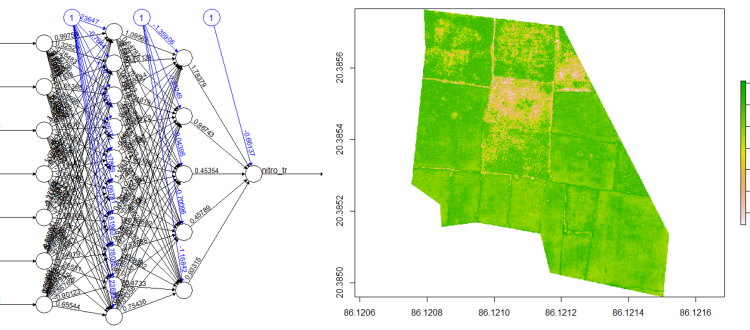
- Home
- About Us
- What We Do
- Partners
- ICAR-Indian Agricultural Research Institute, New Delhi
- ICAR-Indian Agricultural Statistics Research Institute, New Delhi (IASRI)
- ICAR-National Rice Research Institute, Cuttack (NRRI)
- ICAR-Indian Institute of Wheat and Barley Research, Karnal (IIWBR)
- ICAR-Central Institute of Cotton Research, Nagpur (CICR)
- ICAR-Indian Institute of Vegetable Research, Varanasi (IIVR)
- ICAR-National Research Centre on Banana (NRCB)
- ICAR-Indian Institute of Soil Science, Bhopal (IISS)
- ICAR- National Bureau of Soil Survey and Land Use Planning, Nagpur (NBSS&LUP)
- ICAR-Indian Institute of Water Management, Bhubaneshwar (IIWM)
- ICAR-Central Institute of Agricultural Engineering, Bhopal (CIAE)
- ICAR- Central Institute of Post-Harvest Engineering and Technology, Ludhiana (CIPHET)
- ICAR-National Dairy Research Institute, Karnal (NDRI)
- ICAR-Central Institute of Fisheries Education, Mumbai (CIFE)
- ICAR- Central Inland Fishery Research Institute, Barrakpore (CIFRI)
- ICAR- Central Institute of Fresh Aquaculture, Bhubaneswar (CIFA)
- Tools / Web Services
- Publications
- Gallery
- Committee
- Contact Us
Achievements
ICAR-National Rice Research Institute
1. Greenseeker based N second top dressing recommendation in rice for Eastern India
Nitrogen is deficient in most Indian soils and shares a high proportion of the fertilizer cost in rice production. Improper N application leads to low N use efficiency as well as high greenhouse gas emissions. Using NDVI from Greenseeker sensor in season estimated yield potential (INSEY) can be predicted for rice cultivation. Therefore, using this INSEY and grain yield data of Rabi and Kharif 2022, we developed an algorithm for optimizing the right dose of N second top dressing. For achieving this objective, an experiment was conducted at ICAR-National Rice Research Institute’s experimental farm in Cuttack, Odisha with six different rice varieties (CR Dhan 312, CR Dhan 310, Lalat, Shatabdi, Swarna Shreya and CR Dhan 206) in Rabi and Kharif 2022 with different N doses, i.e., 0, 40 80, 100 and 120 kg N ha-1 to create variations in N content in rice. The second topdressing recommendation varied from 17.6 to 27.2 kg N ha-1 based on the basal and first topdressing application applied in the plot. The total N fertilizer dose in Greenseeker recommended plots varied from 79.69 to 95.25 kg N ha-1.


2. Development and validation of android based “riceNxpert” mobile application in the farmer’s trial
ICAR-NRRI has developed one android based application “riceNxpert” which is available free of cost in the Google play store. This app is used to monitor and recommend N topdressing requirement by analysing 10 photographs of rice leaves. Experiments were conducted to validate the reiceNxpert based N recommendation in farmer’s field (Rabi, Kharif 2022, 2023) with 40 farmers at six locations comprising 4 districts of Odisha.



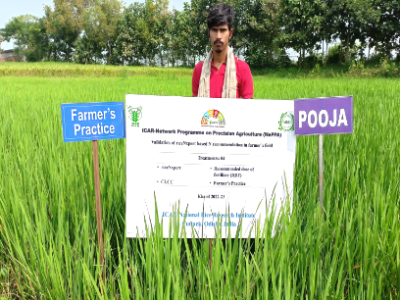
3. Predicting Chlorophyll and N content in rice leaves using optical sensors
Estimation of chlorophyll and N content in rice is a crucial to optimize nitrogen (N) fertilizer application. There are several laboratory methods to estimate leaf chlorophyll and N content destructively, which are costly, require expertise and time consuming.
The riceNxpert was tested for both DSR and transplanted rice. The varieties with short duration (Naveen, Lalat and Sitabhog; Maturity in 120-130 days) as well as long duration (Ranjit, Gayatri, Pooja, Swarna Sub 1 and Kala Champa; Maturity in 150-160 days) were selected. riceNxpert based N management resulted in 10.4% – 43.6% higher yield compared to farmer’s practice in the six farmer’s field trials due to right dose and right time of application of Nitrogenous fertilizers.
Since technical advancements have made it feasible to promptly and non-destructively assess the chlorophyll and N content status of crops based on leaf spectral features, in this study, Greenseeker (GS), leaf colour charts (LCC), and Soil Plant Analysis Development metre (SPAD) measurements were utilised to create multiple regression-based models for predicting chlorophyll and N content of rice. Destructive plant sampling for estimation of leaf chlorophyll and N content as well as, NDVI, SPAD and CLCC measurements were performed at 45, 49 and 54 days after transplanting. The leaf samples were analysed in the laboratory to estimate Chlorophyll a, Chlorophyll b and total Chlorophyll concentrations (Porra et al., 1989) and total leaf N content of rice (Kjeldahl, 1883). The MLR models were developed using the Statistical Analysis System (SAS) (SAS Institute, 2011). Multiple linear regression (MLR) models with two variables i.e., NDVI and SPAD data from Greenseeker and SPAD optical sensors, satisfactorily predicted the chlorophyll and N content of rice varieties based on the higher R2 values and lower prediction errors i.e., mean square error (MSE), mean absolute deviation (MAD) and root mean squares error (RMSE).

4. Estimating soil organic carbon (SOC) levels using Drone mounted sensors and machine learning algorithms
Rapidly and accurately estimating soil organic carbon (SOC) from different matching learning algorithms can help understand farmland soil fertility and serves managing mineral fertilizers. The pedogenesis theory provides a fundamental basis for digital soil mapping by environmental factors. However, these soil forming factors may be insensitive to soil properties in low relief areas, such as plains or small-scale farmlands.
To overcome this problem, machine learning algorithms model was developed for prediction SOC. Based on the relationships between SOC and vegetation indices. Two machine learning models i.e., random forest (RF) and support vector machine (SVM) were used for the prediction of SOC. The correlation matrices suggested significant correlations between NDRE, IPVI, GNDVI, MSAVI and SAVI with SOC for UAS dataset. The accuracy parameters of the model depicted that the RF model was more accurate in predicting SOC in comparison to SVM model. SOC prediction maps can also be estimated
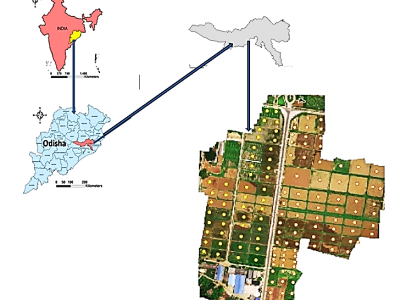
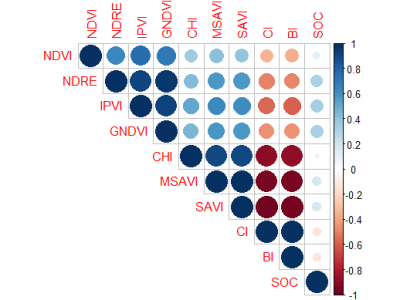
5. Developing precision nitrogen management protocols for rice using remote sensing and geospatial tools
Upscaling the Nitrogen recommendation to farmers’ field using multispectral satellite sensors and/or drone mounted sensors for enhancing nitrogen use efficiency. Our methodology for this specific objective, encompasses a comprehensive data collection and processing phase, followed by the development of a predictive model for nitrogen estimation in crop fields. We collected multispectral imagery using drones and performed various data processing steps, including orthorectification and spectral index extraction. Our model development involved calibrating spectral indices with ground data, selecting independent variables using the Stepwise VIF technique and optimizing the Random Forest model by tuning the ‘ntree’ hyperparameter. The final model’s performance was evaluated on a validation dataset, and we identified key influential variables. Additionally, the model’s predictions were used to generate nitrogen level maps for the study area, highlighting the practical application of our work
